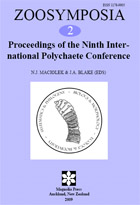Abstract
This study identifies to species or species units 572 lots (>1000 specimens) of pilargids from six localities in the Arafura Sea and Gulf of Carpentaria (including the ports at Gove and McArthur River). We analyze the taxonomic data against geomorphic unit, depth, and sediment type. Preliminary results show that pilargid fauna of northern Australia comprises 13 species in seven genera (Ancistrosyllis, Cabira, Litocorsa, Loandalia, Pilargis, Sigambra, and Synelmis). Although all four localities have a similar diversity of species (six or seven species each), the species composition differs between each region: Litocorsa annamita and Synelmis rigida were found in all sediment types in the Arafura Sea and Gulf of Carpentaria; Ancistrosyllis cf. hartmanae (mud and sand dominated sediments only) and Sigambra pettiboneae (all sediment types) were restricted to the inshore localities of Gove and McArthur River; Loandalia gladstonensis and Sigambra sp. 2 were found on the shelf and in the inshore habitats of the Gulf of Carpentaria only; Litocorsa sp. ‘arafura’, Sigambra sp. ‘arafura’ and Synelmis gibbsi were found only in the Arafura Sea, with sediments dominated by sand and gravel; and Cabira sp. 1 and Sigambra cf. tentaculata were found at all locations, in all sediment types. Based on these distribution patterns and the Recent Quaternary geological history of the area, hypotheses of post-glacial colonization of the Gulf of Carpentaria are presented. The pilargid species composition in northern Australia is also compared to neighboring Indo-west Pacific regions.

